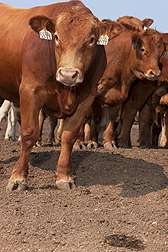The lifetime journeys of manure-based microbes

Studies at the U.S. Department of Agriculture (USDA) are shedding some light on the microbes that dwell in cattle manure—what they are, where they thrive, where they struggle, and where they can end up.
This research, which is being conducted by Agricultural Research Service (ARS) scientists at the agency's Agroecosystems Management Research Unit in Lincoln, Neb., supports the USDA priority of ensuring food safety. ARS is USDA's chief intramural scientific research agency.
In one project, ARS microbiologist Lisa Durso used fecal samples from six beef cattle to identify a core set of bovine gastrointestinal bacterial groups common to both beef and dairy cattle. She also observed a number of bacteria in the beef cattle that had not been reported in dairy cows, and identified a diverse assortment of bacteria from the six individual animals, even though all six consumed the same diet and were the same breed, gender and age.
In another study, Durso collaborated with ARS agricultural engineer John Gilley and others to study how livestock diet affected the transport of pathogens in field runoff from manure-amended soils. The scientists added two types of manure to experimental conventional-till and no-till fields at 1-, 2-, or 4-year application rates. The manure had been collected from livestock that had consumed either corn or feed with wet distillers grains.
After a series of simulated rain events, the team collected and analyzed samples of field runoff and determined that neither diet nor tillage management significantly affected the transport of fecal indicator bacteria. But they did note that diet affected the transport of bacteriophages—viruses that invade bacteria—in field runoff.
Gilley also conducted an investigation into how standing wheat residues affected water quality in runoff from fields amended with 1-, 2-, or 4-year application rates of manure. The scientists found that runoff loads of dissolved phosphorus, total phosphorus, nitrates, nitrogen, and total nitrogen were much higher from plots with residue cover. The team also observed that runoff from fields amended with 4-year application rates of manure had significantly higher levels of total phosphorus and dissolved phosphorus than fields amended with 1-year or 2-year manure rates.
Results from these studies have been published in Foodborne Pathogens and Disease, Applied and Environmental Microbiology, and Transactions of the ASABE.
More information: Read more about this research in the February 2013 issue of Agricultural Research magazine: www.ars.usda.gov/is/AR/archive/feb13/cows0213.htm
Journal information: Applied and Environmental Microbiology , Agricultural Research
Provided by United States Department of Agriculture















